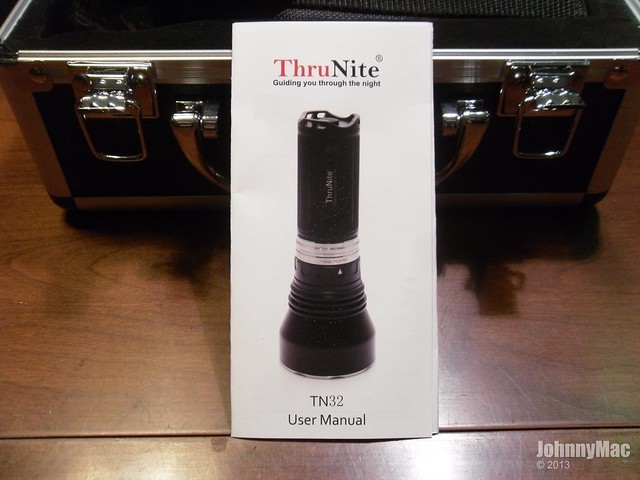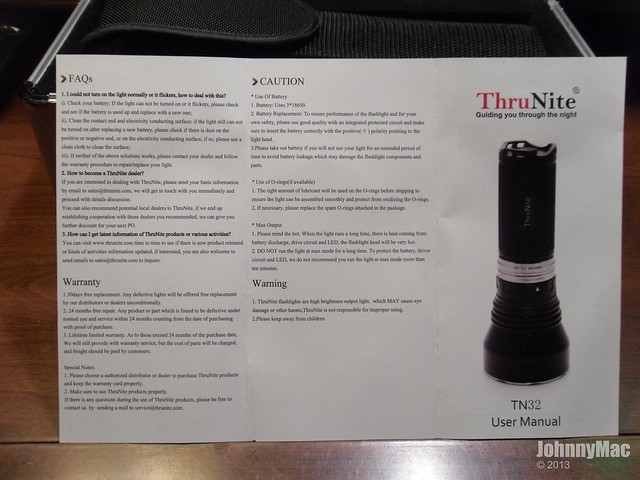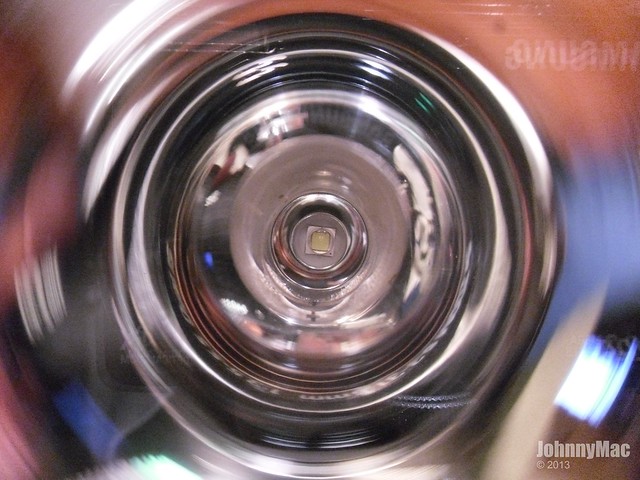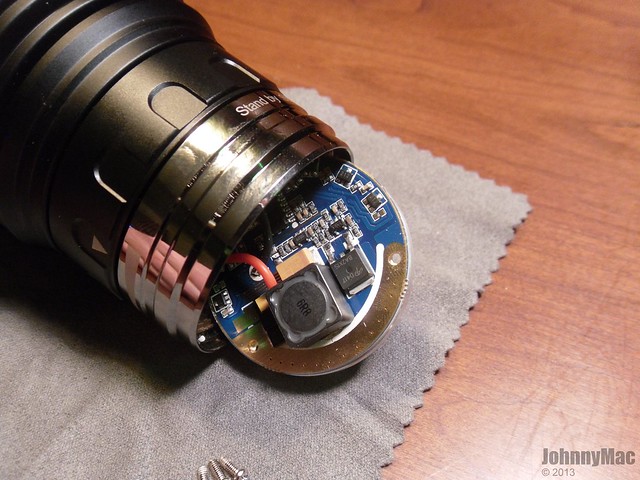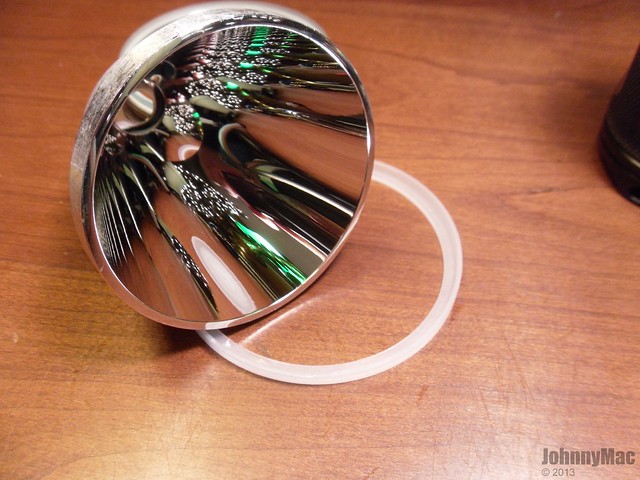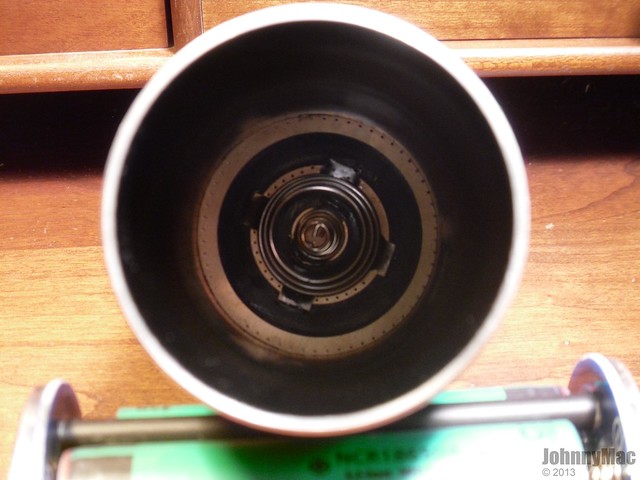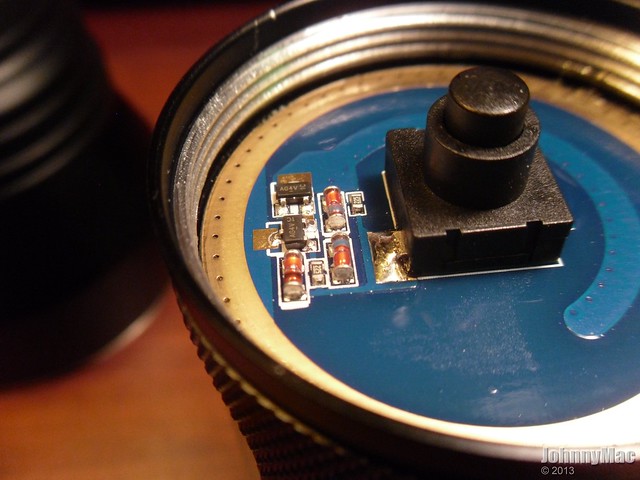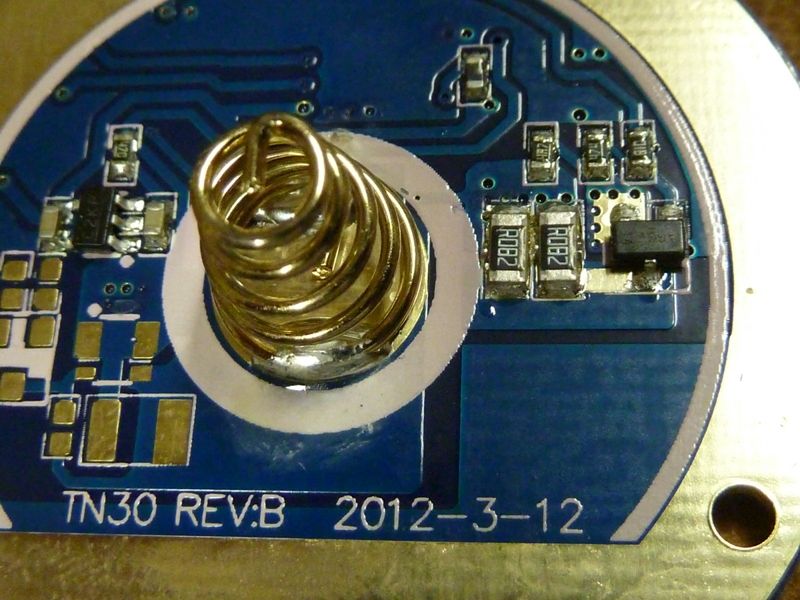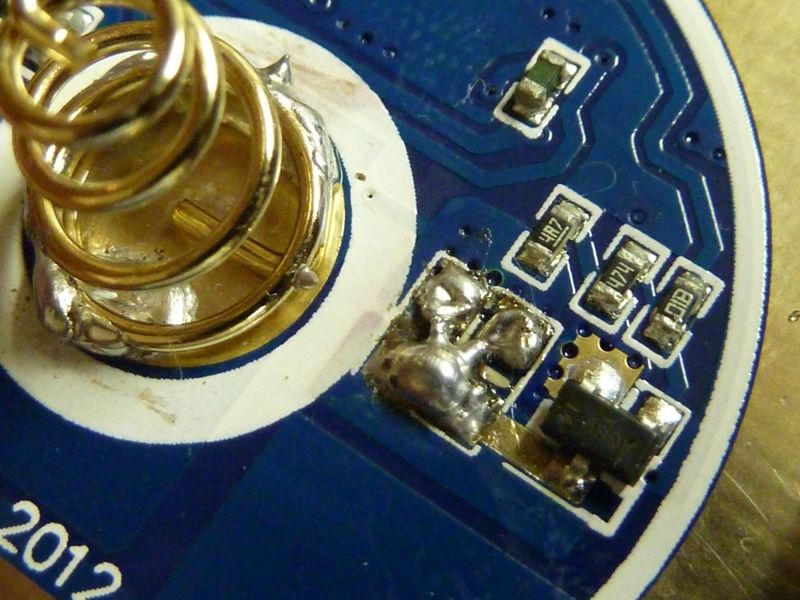ThruNite TN32 Tactical/Search Flashlight
When ThruNite offered me the opportunity to review their newest update of the venerable TN31, the new TN32, I jumped at the chance. The TN31 has always been one of the best throwing and well respected flashlights designed for long range throw. With the release of the new TN32, ThruNite has upped the ante by adding a solid copper alloy pill and improving driver output to drive it's Cree XM-L2 to a claimed 1702 lumens. Does it live up to it's promise? Read on and see what my test results show. Let's start off with sharing the features and specifications from ThruNite-store.com
Description from ThruNite's website:
![]()
Designed for flashaholics only, ThruNite TN32 is much brighter than TN31. TN32 has a max output of 1702 lumen, even more powerful than TN31 XM-L2 version whose output is 1376 lumen. Copper plating chromium circuit provides better heat dissipation performance.Otherwise it has a streamline design and very beautiful body. It weights only 650 grams and very light to carry on. It is good for tactical and search purposes.
Key Features:
☆ Copper circuit provides better heat dissipation performance
☆ Improved UI for more lumens
☆ Ultra-clear tempered glass lens with anti-reflective coating.
☆ Momentary forward click tactical switch.
☆ Strobe mode for tactical and emergency use.
☆ Smooth reflector for max light output.
☆ Highly focused beam for maximum distance
☆ Tactical knurling for firm grip.
☆ Streamlined body design.
☆ Mechanical reversed polarity protection design for battery carrier.
☆ Intelligent highly efficient circuit board design for max performance and long run time.
☆ Specially designed for Military, Law Enforcement, Self-defense, Hunting, Search & Rescue and Outdoor activities.
☆ Intelligent temperature controlled light output for user safety.
Specifications:

Accessories: Hoster,Lanyard,User manual,Warranty card,O-ring
Retail price: $179.00 USD
![]()
First impressions are everything and the ThruNite TN32 doesn't fail to impress. Unboxing the shipment revealed a beautiful and sturdy case in which the TN32 is snuggly encased inside it's holster along with some spare O-rings, a nice lanyard, user manual and a warranty card.
The case the TN32 comes in is extremely attractive and well built. I was impressed immediately with it's quality before ever opening it. Perhaps it's because of the anticipation I had for this light but it feels nicer, somehow, than the one that came with my TN30.
Opening the latches and raising the lid reveals a holstered TN32 and user manual. The interior of the lid is covered in egg crate foam. The main section is an extremely dense closed cell foam cut to fit the holstered TN32 perfectly.
I'm including a look at the owner's Manual. Nothing too detailed or mysterious in it since the light couldn't be easier to figure out or operate. The English is very good and, unless I overlooked it, contains no "Chinglish" that one normally sees with lights made in China.
Here are the contents of the case. The spares packet, lanyard, and warranty card are stowed below the holster in the bottom of the case.
A better look at the interior of the case.
Inside the holster, the light comes wrapped in a thick plastic bag that covers the front 2/3 of the light.
The TN32 looks like a flashlight should. It's 79mm head only begins to suggest how well it throws.
The chromed one-piece pill tells you that the TN32 is different from the older TN31 model from which it has evolved.
An XM-L2 U2 sits at the base of the reflector. Even domed, when combined with the beautiful reflector if puts out an impressive 270,920 lux and throws over 1000 yards! Been longing for a Vinh modded TN31 that puts out roughly 5000k? Thrunite has done the mods for you except for dedoming the XM-L2 emitter. They even beefed up the pill with a one piece solid copper alloy (CuZn) exposed pill (Chrome plated on the exterior). You can't do any better than this and for only a little more than the cost of a standard TN31. Still not enoough to impress you? Lets take a look at the rest of the light in closer detail.
A look from the front shows the TN32 means business. The crenelated stainless steel bezel has zero sharp edges even though it looks like it should. This is just an example of the machining and finish of the TN32.
No burrs on the bezel crenelations plus a 3mm thick ultraclear glass lens that is AR coated. The interior of the reflector is perfectly proportioned for thow at 65mm wide * 65mm deep.
The body of the light has 3 machined flats. One of which contains the Model number of the light along with the individual lights Serial Number.
A second flat has the Thrunite logo and motto. All etching on the body is consistent, white, and cleanly lasered. It was quite nice to see the imjproved quality of the etching after seeing the rather poor etching done on the TN11S I reviewed a while ago.
The knurling is some of the best I've seen. Extremely aggressive and grippy but with no sharp edges or burrs anywhere. Just a consistent, wonderful grip wet or dry. The triple parallel cell format may prove to be a touch wide in diameter for those with smaller hands but it is very well balanced and not at all front heavy like I expected it to be. It is very comfortable.
The head of the TN32 is smoothly machined and anodized. It even looks better in person than it does in photos.
The fins at the base of the reflector cup aid in transferring heat from the over-driven emitter away from the light and into the surrounding air.
Directly behind the finning is the magnetic rotating control ring that allows selection from the 6 main output levels plus standby and strobe.
The chromed ring at the base of the head is actually the exposed area of the pill. It is machined from solid copper alloy (CuZn) and chromed on the outside for durability and finish appearance. This new copper alloy pill is basically brass but it definitely does handle the heat the increased output of the driver causes the TN32 to create.
Just another look at the excellent machining and anodizing on the head.
At the opposite end of the light we have the crenelated tail cap and main power switch. You can see how every edge is beautifully chamfered, even the lanyard hole edges are wonderfully machined and chamfered. There is none of the exposed aluminum on the edges like I've seen on many other lights nor should there be on a light that currently lists at $179 USD. To many people it's a lot of money to spend on a flashlight but it is truly money well spent.
Here you can see the impressive machining and little details that make this such a wonderful light.
The output marking are laser etched into the outer collar of the pill. You can see the arrow head etched onto the control ring. As you rotate the ring the arrow points to the output mode selected.
Here you can see the markings for Standby and Strobe.
With the body unscrewed from the head we now take a look at the back of the head. here we can see the exposed copper/brass in the nicely machined threads. An aluminum contact plate for the battery negative contact and the very thick gold-plated spring for the battery positive connection in the center.
3 stainless phillips head screws hold the contact plate to the head. With them removed we can see the backside of the plate. Note that it is recessed to clear a few surface mounted components on the outer face of the driver PCB.
With the contact plate removed we can see the rear of the driver PCB. The dab of thermal grease must be there to help wick heat off of a component and into the contact plate.
Not the greatest view of the driver but I didn't feel like unsoldering it to get a better picture. The full size pic will show greater detail for those interested. Since I don't have an original TN31 I am only assuming that it is the same driver but with a few component changes (sense resistors) to increase the output to the LED.
A closer look at the inside of the emitter/driver pill. You can see the copper/brass well from here. The copper MCPCB with direct thermal path for the emitter is mounted directly to the other side of the copper pill. Heavy gauge wiring is used for minimal electrical resistance.
At the front of the head we have another look at the gorgeous and effective reflector.
With the bezel and lens removed we can see the 2mm thick O-ring that sits between the bezel and glass. There is a groove machined in the bezel into which the O-ring sits.
The AR coated lens is 72.4mm wide and 3mm thick.

You can see how nicely finished and chamfered even the edges of the bezel are. Attention to detail abounds in the TN32.
Beneath the bezel and lens is an L-ring which sits on top of the reflector and presses snugly against the inner walls of the head. The lens sits inside of this and when everything is tightened down it completes a tight seal protecting the TN32 from moisture ingress.
Here we have the reflector outside the head.
The L-ring seal measures 75mm across.
The outer diameter of the reflector measures 69.56mm.
Reflector depth is 65mm.
Inside diameter of the reflector measures 65mm as well.
Inside at the base of the head is the copper MCPCB onto which the XM-L2 emitter is mounted. The copper MCPCB provides direct thermal connection from the emitter base to the MCPCB while two screws mount the copper MCPCB to the solid copper pill.
Switching attention back to the body of the light, let's take a closer look at the reverse protected battery holder. Here we see the end of the holder where it connects to the driver contact board. The carrier itself is designed to work if either end is connecting to the driver. This takes out the worry of inserting it incorrectly and shorting out the driver board.
In previous TN31 and TN30 models some owners complained that a thin coating on some of the battery carriers caused poor connection and flickering. I noticed no such issues but did lightly sand the carrier connection surfaces with 600 grit emery cloth just to make sure there was no coating interfering with anything. This picture was taken before I sanded the faces lightly.
Threads are deeply cut O-ring is nice and thick and seals very tightly to keep the light waterproof to 2 meter rating.
The carrier is very solid with gold plated springs and solid connection buttons for the cells. It will accommodate cells up to 69mm in length.
Here are my unprotected test cells. The carrier will also fit most protected cells but not all. Anything more than 69mm may require some shimming of the posts that connect the contact plates.
A look down the body tube shows the contact plate and contact springs at the tube's base.
The end cap threads off with a tough grip but most of that is due to the thick O-ring that seals the cap from water ingress.
The tail switch boot is held in place from behind by a wide, threaded retaining ring. To swap the boot just insert needle nose pliers into the two indents and unthread.
The tail switch itself is a forward clicky switch and is mounted directly to the tail PCB. Also included are some surface mounted components. I'm not enough of an electronics hobbyist to tel you what exactly these do. I am going to guess that they buffer the flow of juice to the driver when the light is switched on. When in the lowest mode and you use the forward clicky switch to signal you will see a slight delay in the light going out when you turn the main power off. In higher modes this effect isn't noticeable.
Here we see the switch PCB removed from the body so we can look at the dual spring setup that provides the reverse protection for the battery carrier. The inner spring is the positive contact and the outer spring is the negative.
A look into the battery tube with the tailcap off and carrier removed. You can see the ledge that the switch PCB sits on.
RECORDED MEASUREMENTS:
| Head Diameter: | 78.85mm |
| Body Diameter: | 49mm |
| Total Length: | 202mm |
| Driver Diameter: | 44mm |
| Lens Diameter * Thickness: | 72.41mm * 3mm |
| Lens O-ring Diameter * Thickness: | 72mm * 2mm |
| Reflector O.D.*I.D.*Depth | 69.65mm*65mm* 65mm |
| Tailcap Diameter: | 16mm |
| Maximun Cell Length: | 69mm |
| Switch Type: | Forward-clicky |
| PWM in any of the modes? | No |
| Waterproof to 2m | Yes |
| Beam angle / Spill angle | 7 degrees / 54 degrees |
All together I have to give the ThruNite TN32 a very high build quality rating. This thing is a very well put together and finished piece of hardware. You might be thinking, "Build quality is nice but what about the performance? Does this light live up to the hype?". Well, since you asked...yes. Yes it does!
![]()
PERFORMANCE:
Performance? Yeah the TN32 has it and in spades! When I heard about the claimed 1702 lumens output on this light I figured it was the usual "at the emitter" lumens. It's not. Much to my amazement, when I tested the TN32 in my Integrated Sphere I saw 1688 OTF lumens. OUT THE FRONT! One word..."NICE!"
Beam output and profle is VERY nice. The hotspot is extremely defined with a very tight and even corona. The spill is a pretty consistent and even from the corona all the way to the defined outer spill edge. Many lights have several defined levels in their spill. The TN32 has just one smooth and artifact free spill. Pretty impressive IMO.
The magnetic control ring operates very smoothly with just the right amount of resistance that you won't accidentally rotate the ring and change modes. Each mode snicks nicely into place with a soft, precise click. From one end of the rotation to the other is about 170 degrees
In Moonlight mode (0.46 lumen) I can actually see the hotspot from over 10 yards out. In it's highest mode the output is simply stunning. There aren't many production LED flashlights that output over 270k lux. The lux and throw ratings from the manufacturer appear to be from the TN31 and are nowhere near what this light actually puts out. Based on the output I would estimate the TN32 to be driven at about 6 amps. If the emitter was dedomed I'm sure it would put out between 450k and 500k lux which is what modified TN31 models are getting when driven at this level and dedomed. Even with the copper/brass pill in the TN32 and everything else being equal it would be very safe to say it would do over 500k if dedomed. If you can wield a soldering iron and have a cup of gasoline handy you can do this yourself and have a light with output that destroys nearly all other throwers and all for the price of $179 USD.
Output Measurements
The output levels, controlled current and zero PWM coupled with three 18650 cells equals a ton of run time for emergency lighting as well as insane output for roughly 1.5 hours. Cells used in measurements are Panasonic NCR18650A unprotected fully charged. Integrated Sphere used is calibrated and very accurate. Lux output measured at 10 yards and converted to 1yd.
| MODE | OTF LUMENS |
| Mode 1 | 0.46 lumen |
| Mode 2 | 17.27 lumens |
| Mode 3 | 307.4 lumens |
| Mode 4 | 743 lumens |
| Mode 5 | 1,199 lumens |
| Mode 6 @ turn on | 1751 lumens |
| Mode 6 @ 30 seconds | 1688 lumens |
| Step-down from Mode 6 (65 seconds) | 1558 lumens |
| LUX and THROW | |
| Lux @ 1yd (converted from 10yds) | 270,920 lux |
| Lux @ 1 meter | 226,529 lux |
| Throw distance in yards | 1,041 yards |
| Throw distance in meters | 951.9 meters |
Pretty hard for me to get any decent outdoor beam shots right now between the holidays and the weather but here are some animated gifs showing differences in output levels. As with all the pictures in this review, clicking one will open a larger version in a new browser window or tab.
CONCLUSION:
Budget light? Nope. Worth the $179 USD entrance fee? Absolutely and every penny of it. It's really the only larger light you would need due to the versatility in output and range. Should provide years of excellent service as well due to the extremely good build quality. I can recommend the TN32 with absolutely no reservations. Looking for a quality thrower that can destroy anything in it's price bracket as well as nearly any other price bracket? Look no further than the ThruNite TN32.
*The light provided in this review was provided by ThruNite-store.com
Edit: I will say that there has been confusion over the material used in the pill. It is definitely not pure copper and frankly I find it totally understandable. It is a copper alloy which, in reality, is merely brass. Pure copper is a bear to machine on a good day and far to soft for threads to hold up reliably, especially in the piece that will be threaded and unthreaded every time the batteries are changed/charged. Is it really any better than having used the same aluminum pill that is found in the TN31? Many might argue that it would be better with an aluminum pill instead of brass (copper alloy to the marketing folks) but their testing gives them the confidence to drive the light at 6+ amps and still cover the light with the standard warranty. My testing showed no issues and lumen output on Turbo only dropped by 80 or so in the first 30 seconds and I don't consider that to be too bad.
I have asked the owner of ThruNite what exact composition of the brass is used in the TN32. He is checking with his engineering team and promises an answer ASAP. Considering that there are dozens of different types of brass it is not worth assuming that the worse type for thermal efficiency was used. Should it matter that much to you then just get a TN31 and perform the resistor mod on it to achieve the same output levels. I find the new design far more appealing cosmetically and am not worried about performance issues.





